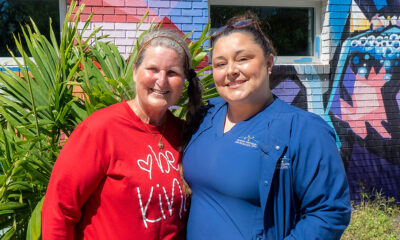Innovate
State of Science: What can we learn from listening to fish?

The water is not silent.
That’s the business case for David Mann’s Loggerhead Instruments, a company that designs and manufactures tools for scientists and others to study the natural world, including underwater acoustic recorders and cameras.
The technology can be used in applications as diverse as sonar, environmental monitoring and navigation, seismic exploration, weather and climate observation and marine biology.
Mann, who started Loggerhead Instruments while he was an associate professor at University of South Florida College of Marine Science, was one of eight speakers who gave rapid-fire presentations on their work during the St. Pete Innovation District’s inaugural State of Science event on Oct. 10.
He demonstrated how the underwater recorders measured the approach of red tide, which has caused at least $129.7 million in economic damages at 233 businesses in nine Florida counties. Mann played a recording at Longboat Key from Aug. 1, when snapping shrimp, which make a sound like frying bacon, could be clearly heard. In contrast, a recording made on Sept. 1 was completely silent.
Loggerhead Instruments’ main products are underwater dataloggers, a low-volume high-margin ocean instrument sold to scientists, environmental consulting groups and the U.S. Navy. Mann didn’t disclose his revenue from those products, but said the company is profitable.
He is self-funding his goal of building a network of acoustic stations around the entire U.S. shoreline, a project he estimates would cost about $1 million. As of last week, he had three listening stations in the backyards of homes in Sarasota Bay and was planning to install more in the coming days.
Other speakers gave updates on tracking red tide and mapping the Florida coastline, as well as innovations in medicine.
See the gallery below.
StateOfScience
The Innovation District reflects the diverse growth of St. Petersburg, as well as the Grow Smarter initiative, developed in collaboration with the St. Petersburg Area Chamber of Commerce, Mayor Rick Kriseman said. That strategy calls for growth in marine and life sciences and data analytics, among other industry groups.
“Many cities hope to have a section of their city that’s devoted to science. This is our first attempt to take what is naturally occurring in the area and create great synergies,” said Dr. Jonathan Ellen, president of the St. Pete Innovation District board. Ellen is also president, CEO and physician-in-chief of Johns Hopkins All Children’s Hospital, and vice dean and professor of pediatrics with the Johns Hopkins University School of Medicine.
The city is full of innovators and opportunities that go beyond the physical boundaries of the district, Ellen said. “I think our next year is devoted to trying to bring in all the innovation.”







